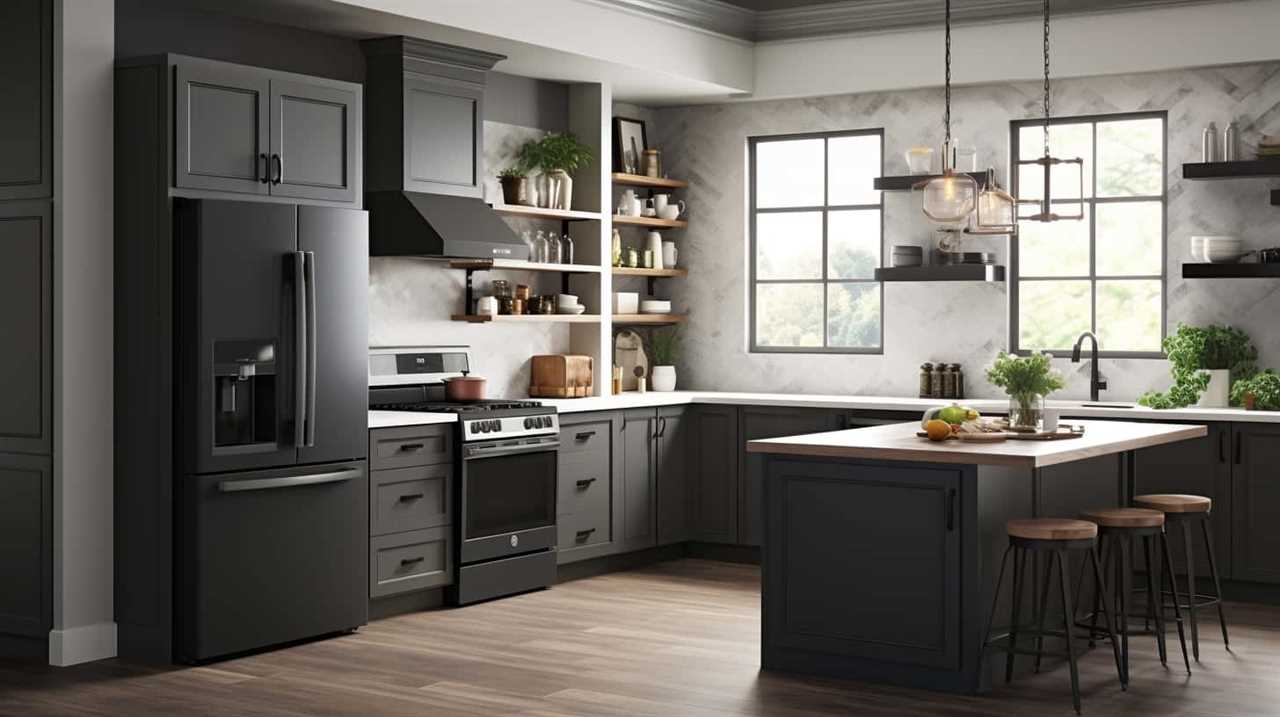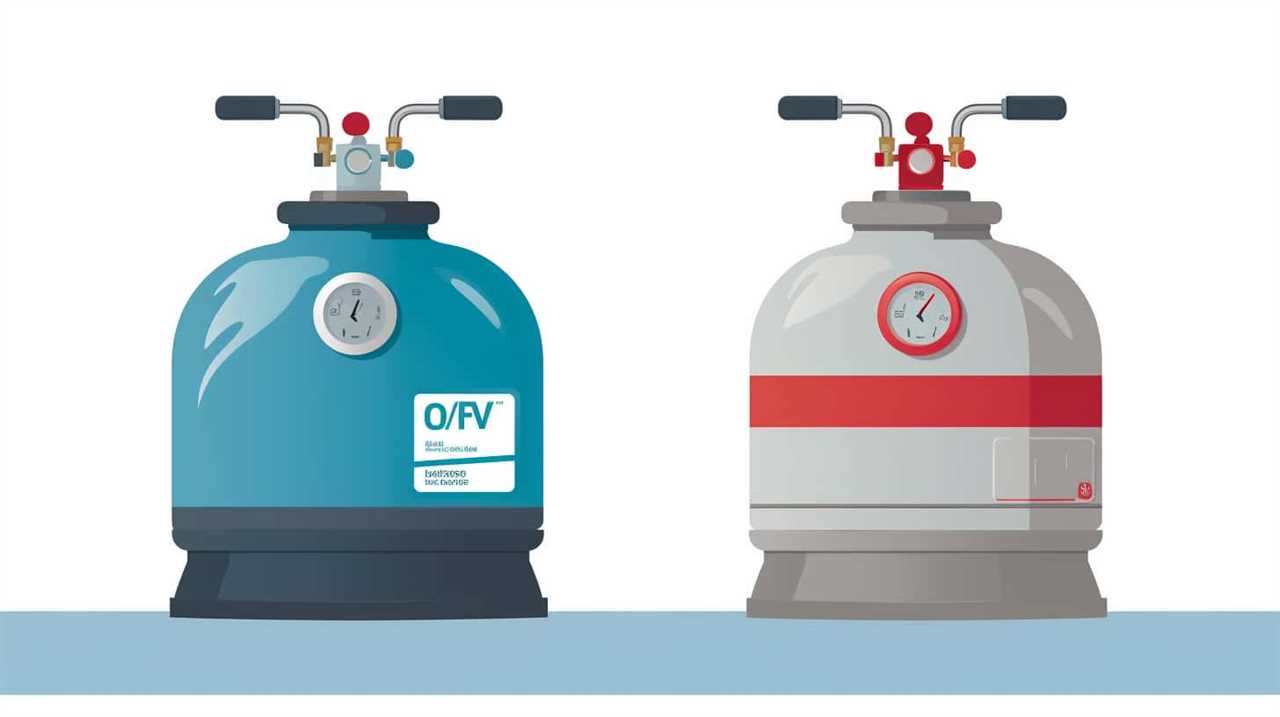Smart home systems are transforming the way appliances are integrated, and we are here to elaborate on the reasons why. These systems provide a variety of advantages, including:
- Improved efficiency and convenience
- Seamless control and monitoring
- Enhanced energy management
- Integration with virtual assistants
- Increased security and safety features
- Customizable automation options
- Interconnectivity of appliances
They provide a new level of mastery over our homes, allowing us to effortlessly manage and optimize our appliances. With smart home systems, we can streamline our daily routines, reduce energy consumption, and enhance our overall living experience.
The potential for expansion and future advancements in this field is immense, promising even more exciting possibilities for appliance integration. So, let’s delve into the world of smart home systems and discover how they are reshaping the way we interact with our appliances.
Key Takeaways
- Optimized energy consumption through monitoring and management
- Remote control capabilities via mobile apps or voice commands
- Valuable insights and data about appliance usage and energy consumption
- Cost-saving automation options for optimizing energy usage
Improved Efficiency and Convenience
Smart home systems enhance our daily lives by improving efficiency and convenience through several key features. Firstly, these systems optimize energy consumption by allowing homeowners to monitor and manage their energy usage. This enables informed decisions to reduce carbon footprints and lower utility bills. For example, smart home systems can automatically adjust temperature settings, turn off lights when not in use, and regulate power consumption of appliances.

Secondly, smart home systems offer a user-friendly interface that simplifies the management of devices and appliances. Homeowners can control and monitor their smart devices from anywhere using mobile apps or voice commands. This provides convenience and peace of mind, as tasks such as adjusting the thermostat before arriving home or checking if the oven is left on can be easily done remotely.
Seamless Control and Monitoring
We have seamless control and monitoring of our appliances through smart home systems. This technology allows us to have real-time monitoring and control over our appliances from anywhere, using our smartphones or other connected devices. With the help of advanced analytics, smart home systems can provide us with valuable insights and data about our appliance usage, energy consumption, and overall efficiency.
Here are some key features that make seamless control and monitoring possible through smart home systems:
- Remote Access: Smart home systems enable us to access and control our appliances remotely, even when we aren’t at home. This means we can turn on/off devices, adjust settings, and monitor their performance from anywhere, providing us with convenience and flexibility.
- Real-time Monitoring: By integrating our appliances with smart home systems, we can monitor their status and performance in real-time. This allows us to keep track of energy consumption, detect any malfunctions or issues, and take immediate action to optimize efficiency.
- Advanced Analytics: Smart home systems can analyze the data collected from our appliances and provide us with valuable insights. By using advanced analytics, these systems can help us identify patterns, optimize energy usage, and even suggest ways to improve appliance performance.
With seamless control and monitoring, smart home systems revolutionize the way we interact with our appliances, making our lives more convenient, efficient, and sustainable.

Enhanced Energy Management
Enhanced energy management is a key benefit of smart home systems. With cost-saving automation options, homeowners can optimize their energy usage by scheduling appliances and devices to run during off-peak hours or when electricity rates are lower. This not only helps reduce electricity bills but also contributes to improved energy efficiency, minimizing wastage and environmental impact.
Additionally, the convenience of remote control allows homeowners to monitor and adjust their energy usage even when they’re away from home, ensuring efficient energy management at all times.
Cost-Saving Automation Options
By utilizing smart home systems, homeowners can significantly reduce energy consumption and save on utility costs. These systems offer cost-saving automation options that enhance energy management. Here are two key features:
- Automated Scheduling: Smart home systems allow homeowners to set schedules for their appliances and devices. This means that lights, thermostats, and other energy-consuming devices can be programmed to turn on or off at specific times. For example, lights can be automatically turned off when no one is in the room, or the thermostat can be adjusted to save energy during the day when the house is empty.
- Energy Consumption Tracking: With smart home systems, homeowners can monitor their energy usage in real-time. These systems provide detailed insights into which appliances and devices consume the most energy. This information allows homeowners to make informed decisions about how to reduce their energy consumption and save on utility costs.
Improved Energy Efficiency
With improved energy efficiency, smart home systems optimize energy management and enhance the overall performance of appliances. These systems achieve this by integrating with the smart grid and providing real-time energy consumption analysis. By analyzing the energy usage patterns of different appliances, smart home systems can determine the most efficient way to operate them, resulting in reduced energy consumption and lower utility bills.

Additionally, these systems can automatically adjust appliance settings based on the time of day, occupancy levels, or user preferences, further maximizing energy efficiency. Smart grid integration allows homeowners to take advantage of off-peak electricity rates and renewable energy sources, further reducing their carbon footprint.
By incorporating advanced energy management features, smart home systems are revolutionizing appliance integration and promoting sustainable living.
As we explore the benefits of smart home systems, let’s now delve into the next section about the convenience of remote control.
Remote Control Convenience
- Conveniently controlling appliances and enhancing energy management through remote control capabilities offered by smart home systems
- The advanced feature of smart home technology that allows access and control of appliances from anywhere, at any time, using smartphones or tablets
- The ability to turn off lights, adjust thermostats, and activate or deactivate appliances when away from home
- The convenience and efficiency of managing energy usage through remote control
- Reducing energy waste and lowering electricity bills by ensuring appliances aren’t left running unnecessarily
- Monitoring and optimizing energy usage to make informed decisions and minimize environmental impact
Benefits of remote control convenience in smart home systems:

- Flexibility and convenience of controlling appliances from anywhere
- Efficient energy management through remote monitoring and optimization
Integration With Virtual Assistants
Our smart home system’s integration with virtual assistants enhances our appliance control and simplifies our daily tasks. By utilizing voice recognition technology, we can now interact with our smart home appliances using natural language commands. This allows for a more intuitive and convenient way of controlling our devices, as we no longer need to rely on physical buttons or remotes. Virtual assistants, such as Amazon Alexa or Google Assistant, act as personalized assistants that respond to our voice commands and perform various tasks for us.
To better understand the benefits of integrating virtual assistants into our smart home system, let’s take a look at the following table:
| Virtual Assistant | Features |
|---|---|
| Amazon Alexa | – Voice control of appliances |
| – Integration with other apps | |
| – Personalized recommendations | |
| Google Assistant | – Seamless device integration |
| – Smart home automation | |
| – Voice-controlled routines |
Through voice recognition, virtual assistants can understand and execute our commands, providing us with a hands-free and personalized experience. Whether it’s adjusting the thermostat, turning on the lights, or even ordering groceries, virtual assistants make it easier than ever to control and manage our smart home appliances. With their ability to learn our preferences and adapt to our daily routines, virtual assistants truly enhance the functionality of our smart home systems, making our lives more convenient and efficient.
Increased Security and Safety Features
One of the most significant advantages of integrating smart home systems is the enhanced security and safety features they offer. With the rise of connected devices, homeowners can now enjoy increased privacy and peace of mind through advanced surveillance capabilities.

Here are some key reasons why smart home systems are revolutionizing security and safety:
- Increased Privacy:
- Smart home systems allow users to monitor and control access to their homes remotely, ensuring that only authorized individuals can enter.
- Advanced encryption and secure protocols protect sensitive data, reducing the risk of privacy breaches.
- Advanced Surveillance:
- Smart security cameras equipped with motion sensors and facial recognition technology can detect and identify potential intruders.
- Integration with mobile apps enables homeowners to receive real-time alerts and view live footage, enhancing situational awareness.
By leveraging smart home technology, homeowners can significantly enhance the security and safety of their properties. With increased privacy measures and advanced surveillance capabilities, individuals can feel more secure in their homes.
As smart home systems continue to evolve, we can expect even more innovative features that prioritize the safety and well-being of homeowners.
Customizable Automation Options
Customizable automation options provide homeowners with flexibility and convenience in managing their smart home systems. With personalized scheduling, homeowners can set specific times for their appliances to turn on or off, ensuring that their homes are always comfortable and energy efficient. For example, they can program their thermostats to lower the temperature during the day when no one is home, and then have it automatically increase before they arrive back in the evening. This level of customization allows homeowners to optimize their energy usage and reduce their utility bills.

Voice activated automation takes customization to a whole new level by allowing homeowners to control their smart home systems using voice commands. This means that they can simply speak commands to their virtual assistants, such as Amazon Alexa or Google Assistant, and have their appliances respond accordingly. Whether it’s turning on the lights, adjusting the temperature, or even starting the coffee maker, voice activated automation adds a new level of convenience to managing a smart home.
In addition to the convenience it offers, customizable automation options also provide homeowners with peace of mind. They can create personalized schedules for their lights to turn on and off while they’re away, giving the impression that someone is home and deterring potential burglars. This level of customization gives homeowners control over their home’s security, even when they aren’t physically present.
Interconnectivity of Appliances
By interconnecting appliances, we can streamline and optimize the functionality of our smart home systems. Smart home technology has made it possible to connect various appliances, allowing them to communicate and work together seamlessly. This interconnectivity not only enhances convenience but also improves efficiency and energy management.
Here are two key benefits of appliance connectivity in smart homes:

- Enhanced Automation: With interconnected appliances, homeowners can create intricate automation scenarios. For example, when the smart thermostat detects that no one is home, it can communicate with the smart lights to turn them off and adjust the temperature settings to save energy. This level of automation eliminates the need for manual adjustments and ensures that energy isn’t wasted when it isn’t needed.
- Centralized Control: Appliance connectivity enables centralized control of all connected devices through a single interface, such as a smartphone app or a voice assistant. This allows users to easily monitor and manage their appliances remotely, even when they’re away from home. Whether it’s adjusting the lighting, checking the status of the refrigerator, or starting the washing machine, users have complete control over their appliances at their fingertips.
The interconnectivity of appliances is a game-changer in the world of smart home technology. It offers a seamless and efficient way to manage and optimize the functionality of our homes, enhancing convenience and energy efficiency.
Future Potential and Expansion Opportunities
As we explore the future potential and expansion opportunities of smart home systems, we uncover new market possibilities, enhanced home automation, and seamless integration of smart devices.
With the rise of IoT technology, the smart home industry is poised for exponential growth, offering endless opportunities for innovation and convenience.
As more devices become interconnected and consumers seek greater control over their homes, the potential for smart home systems to revolutionize appliance integration is vast.

New Market Possibilities
In our article, we explore the exciting new market possibilities for smart home systems, highlighting the future potential and expansion opportunities they offer. The integration of smart home systems with appliances opens up a whole new world of possibilities for businesses and consumers alike.
Here are some key points to consider:
- New Business Models:
- Subscription-based services: Smart home systems can offer subscription-based models, where consumers pay a monthly fee for access to advanced features and services.
- Data monetization: With smart home systems collecting vast amounts of data, companies can explore new ways to monetize this data, such as selling anonymized insights to third-party businesses.
- Consumer Behavior:
- Personalization: Smart home systems enable personalized experiences, allowing consumers to customize their environment to their preferences.
- Energy efficiency: With the ability to monitor and control energy usage, smart home systems promote energy-efficient behaviors, leading to cost savings and environmental benefits.
These new market possibilities are reshaping the way businesses operate and consumers interact with their homes, ushering in an era of increased convenience, customization, and sustainability.
Enhanced Home Automation
Our enhanced home automation system’s potential for future expansion is incredibly exciting. As technology continues to advance, the possibilities for integrating home security and voice recognition into our system are endless.

Home security is a top priority for many homeowners, and our enhanced automation system provides a seamless solution. By integrating with smart locks, surveillance cameras, and motion sensors, our system can monitor and protect your home, providing peace of mind and ensuring the safety of your family and belongings.
Additionally, voice recognition technology allows for a more intuitive and convenient user experience. With the ability to control various aspects of your home through voice commands, such as adjusting the temperature, turning off lights, or playing music, our enhanced automation system truly brings the future to your fingertips.
The potential for further expansion and integration in the realm of home automation is vast, and we’re committed to continually pushing the boundaries to enhance the connected home experience.
Smart Devices Integration
The potential for smart devices integration in our enhanced home automation system is vast, offering exciting opportunities for future expansion and enhanced appliance integration. As technology continues to advance, the compatibility of smart homes with various devices becomes increasingly important.

Here are two key subtopics that highlight the future potential and expansion opportunities of smart devices integration:
- Smart Home Compatibility:
- Smart home systems are becoming increasingly compatible with a wide range of devices, including smartphones, tablets, smart TVs, and wearable technology.
- This compatibility enables users to control and monitor their appliances and devices remotely, creating a seamless and integrated user experience.
- Device Compatibility:
- With the growth of the Internet of Things (IoT), more and more devices are becoming interconnected and capable of communication with each other.
- This compatibility allows for the integration of various devices, such as smart thermostats, lighting systems, home security systems, and kitchen appliances, creating a truly connected and intelligent home environment.
Frequently Asked Questions
How Much Do Smart Home Systems Typically Cost?
When considering the cost of smart home systems, it’s important to conduct a cost comparison and benefits analysis.
Smart home systems vary in price depending on the brand, features, and level of integration desired. Factors such as the number of appliances to be integrated and the complexity of the system can also affect the cost.
However, the convenience, energy efficiency, and enhanced security provided by smart home systems justify the investment for those seeking mastery over their home automation.

Are There Any Privacy Concerns With Using Smart Home Systems?
Data security and hacking risks are some of the privacy concerns associated with using smart home systems. With the integration of appliances, these systems collect and store vast amounts of personal data, making them potential targets for hackers.
Unauthorized access to this data could lead to invasions of privacy, identity theft, or even physical harm. It’s crucial for users to be aware of these risks and take necessary precautions, such as setting strong passwords and regularly updating their smart home system’s security features.
Can Smart Home Systems Be Easily Integrated Into Existing Homes?
Integrating smart home systems into existing homes can present some challenges. Retrofitting can be a complex process, as it requires adapting older homes to accommodate new technology. Compatibility issues may arise when trying to connect different devices and appliances.
However, with careful planning and the help of experts, it’s possible to successfully integrate smart home systems into existing homes. It’s important to consider these factors before embarking on the journey towards a fully automated and connected home.

What Are the Potential Drawbacks or Limitations of Using Smart Home Systems?
Potential drawbacks or limitations of using smart home systems include:
- Potential security risks: Smart home devices can be vulnerable to hacking or unauthorized access, which can compromise personal information or even lead to physical safety risks.
- Compatibility issues: Integrating different smart home devices from various manufacturers may lead to difficulties in controlling and managing the entire system efficiently.
It’s important to carefully consider these factors before fully embracing smart home technology.
Do Smart Home Systems Require a Stable Internet Connection to Function Properly?
Yes, smart home systems do require a stable internet connection to function properly. Without a reliable internet connection, the devices within the smart home system may not be able to communicate with each other or with the user. This can result in a loss of functionality and the inability to control and monitor appliances remotely.
However, despite this requirement, the benefits of smart home systems, such as increased convenience, energy efficiency, and security, make them a worthwhile investment for many homeowners.

How Do Smart Home Systems Revolutionize Appliance Integration Through Effective Engagement Strategies?
Smart home systems are revolutionizing appliance integration through effective appliance engagement strategies. These systems are designed to streamline household tasks and improve overall efficiency. By implementing advanced technology, smart home devices are able to optimize appliance engagement strategies effectiveness, making daily life easier and more convenient.
Conclusion
In conclusion, the revolution of smart home systems has completely transformed the way we integrate and interact with our appliances.
With improved efficiency, seamless control, enhanced energy management, and increased security features, these systems offer unprecedented convenience and peace of mind.
But the true beauty lies in their potential for future expansion and interconnectivity, promising even more exciting possibilities.
Brace yourself for a future where your home truly becomes a smart, intuitive, and personalized haven.











